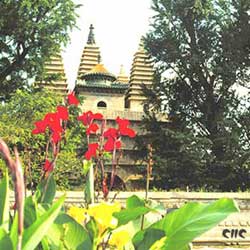
The Five-Pagoda Temple is situated about 200 meters to the northwest of Beijing Zoo. Its original name, the Temple of True Awakening (Zhenjuesi), was later changed to the Temple of Great Righteous Awakening (Dazhengjuesi). Today, however, it is popularly referred to as the Five-Pagoda Temple.
The structure of the five pagodas is known in Buddhist terminology as the "diamond throne pagoda" style, wherein five small pagodas stand on a large square foundation known as the "throne." This architectural form was introduced to China by an Indian monk in the early 15th century, and the Temple of True Awakening was constructed here in 1473. The entire temple complex, including numerous wooden buildings, was repaired and renovated in 1761, but in the late Qing Dynasty it was looted and burned to the ground, first by the Anglo-French Allied Armies in 1860, and again by the Eight-Power Allied Force in 1900. Today, the only extant relic is the monumental diamond throne pagoda.
The architectural style of the temple is no mere imitation of its Indian prototype, but displays bold innovations: the height of the throne foundation was raised, the height of the pagodas was reduced, and typical Chinese glazed tiles were added.
The square throne foundation is 17 meters high. The five pagodas rise from their rectangular bases on top of this foundation, one in each of the four corners and the fifth in the center. The central pagoda is slightly higher than the others, with 13 eaves, two more than those in the corners. The entire structure is made of white marble. Today, after more than 500 years of oxidation, the flecks of iron in the stone have given the entire structure a pale orange cast.
The four walls of the foundation are carved with rows of Buddhas (the One Thousand Sagacious Buddhas) as well as bas-reliefs of Buddhist symbols, floral designs and Sanskrit letters. The five pagodas are also covered with similar carvings on a small scale.
A door at eh foot of the foundation on the southern side opens into an inner spiral stairway that leads to the top pf the foundation.
There are a total of six "diamond throne pagodas" in China. Two others are in Beijing in the Temple of the Azure Clouds (Biyunsi) and the Yellow Temple (Huangsi). One is in Huhehot in Inner Mongolia; another in Kunming, Yunnan Province, in the Miaozhan (Profundity) Temple; and one is in Zhengding, Hebei Province, in the Guanghui (Universal Beneficence) Temple.
Address: No.24, Wutaisi Cun, Baishiqiao, Haidian District;
Entry ticket: 20 yuan;
Opening hours: 9:00 Am -4:00 PM;
Traffic: Bus No.s 320, 332, 717, 941,601, 612, 27 and Trolley-bus No.s 102, 103, 105 and 111;
Tel: 86-10-62173543.
(China.org.cn)
|

